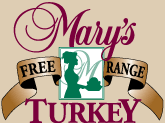Old-style turkeys are back in style
 By Carolyn Jung
By Carolyn Jung
Posted on Wed, Oct. 20, 2004

Mercury News
Richly flavored, free-range, hormone-free,
antibiotic-free and with a majestic lineage to boot.
No wonder Northern Californians fell
hard for heritage turkeys last Thanksgiving and are clamoring for
more for the upcoming holiday. Some farmers and grocery stores
already were fielding calls over the summer from anxious consumers
wanting to know how they could get their hands on these specialty
turkeys. These birds are vanishing breeds, descendants of the
original ones raised in this country by family farmers before
industrialization took hold.
The good news is that getting one
this year should be easier. In California alone, 6,000 heritage
turkeys are being raised now, more than four times as many as last
year. And unlike last year, when folks had to reserve their turkeys
two months ahead of time and then pick them up at designated
drop-off sites, this year consumers can buy them at select groceries
as long as supplies last or get them shipped directly from an area
farm. Andronico's, Mollie Stone's and Draeger's stores in the Bay
Area already have agreed to carry them, as has Shopper's Corner in
Santa Cruz and Berkeley Bowl in Berkeley.
Expect to pay a pretty penny.
Heritage turkeys are likely to sell for about $4 a pound, several
times the price of most turkeys. The higher price tag reflects how
different they are from the average, mass-produced turkey.
People in this country consume 400
million turkeys a year, and almost all of them are Broad Breasted
Whites, a breed with short legs and a huge breast, bred to meet
Americans' overwhelming taste for white meat. They are usually
confined indoors and are often given antibiotics to keep bacteria in
check. They are artificially inseminated because their buxomness and
short stature leave them unable to copulate naturally. And they
can't fly, unlike heritage turkeys, which like to roost in trees.
Heritage turkeys are about 6 months
old when brought to market, compared with 3 or 4 months old for a
mass-market turkey. They have longer legs, less white meat and look
much more aerodynamic in shape. They are sold fresh, not frozen. And
because the birds are leaner, most cooks like to brine them at least
a day before roasting to heighten their juiciness.
Three years ago, Slow Food, a global
organization dedicated to preserving artisanal products, joined with
the American Livestock Breeds Conservancy, a non-profit dedicated to
protecting breeds of farm animals from extinction, to work with
farmers to try to save four of the best-known old breeds of turkey
before they vanished. They are: the Bourbon Red from Bourbon County,
Ky.; the Narragansett from Rhode Island, which was the first
American turkey breed to be developed from ones brought from
England; the Jersey Buff from New Jersey; and the Standard Bronze,
the breed depicted in the classic Norman Rockwell painting ``Freedom
From Want'' and the one Benjamin Franklin proposed as a national
symbol.
In the program's first year in 2002,
about 5,000 heritage turkeys were raised by farmers in Oklahoma and
Kansas. Last year was the first year that California farmers began
raising them.
The exact breed of the heritage bird
you buy at the market won't be specified, but it's a good bet it
will be a Narragansett. That's because farmer Rick Pitman of
Mary's Turkeys in Madera is raising the majority of the heritage
turkeys available in California, and most of his birds are
Narragansetts.
``The response last year was
excellent,'' Pitman says. ``I'm very gratified that grocery stores
are interested this year, because that's where people really want to
pick them up.''
And markets seem happy to take a
chance on the product.
``I'm sure the heritage will do
well,'' says Marc Kane, vice president of meat and seafood at
Andronico's. ``It's a specialty item, but it's not a novelty or a
fad. We're already getting calls from people who are interested.''







